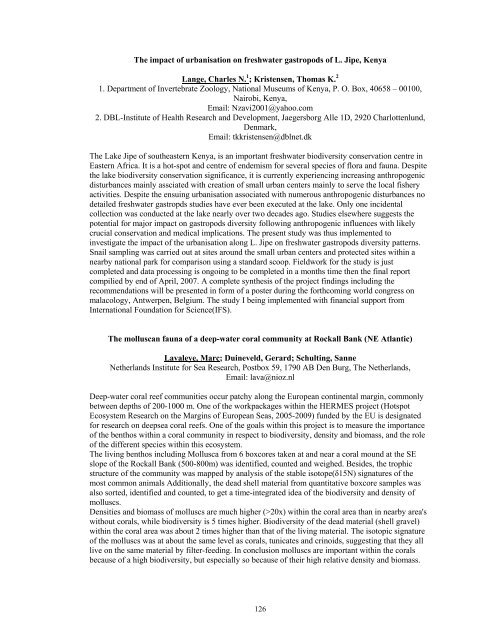World Congress of Malacology Antwerp ... - Unitas Malacologica
World Congress of Malacology Antwerp ... - Unitas Malacologica
World Congress of Malacology Antwerp ... - Unitas Malacologica
You also want an ePaper? Increase the reach of your titles
YUMPU automatically turns print PDFs into web optimized ePapers that Google loves.
The impact <strong>of</strong> urbanisation on freshwater gastropods <strong>of</strong> L. Jipe, Kenya<br />
Lange, Charles N. 1 ; Kristensen, Thomas K. 2<br />
1. Department <strong>of</strong> Invertebrate Zoology, National Museums <strong>of</strong> Kenya, P. O. Box, 40658 – 00100,<br />
Nairobi, Kenya,<br />
Email: Nzavi2001@yahoo.com<br />
2. DBL-Institute <strong>of</strong> Health Research and Development, Jaegersborg Alle 1D, 2920 Charlottenlund,<br />
Denmark,<br />
Email: tkkristensen@dblnet.dk<br />
The Lake Jipe <strong>of</strong> southeastern Kenya, is an important freshwater biodiversity conservation centre in<br />
Eastern Africa. It is a hot-spot and centre <strong>of</strong> endemism for several species <strong>of</strong> flora and fauna. Despite<br />
the lake biodiversity conservation significance, it is currently experiencing increasing anthropogenic<br />
disturbances mainly assciated with creation <strong>of</strong> small urban centers mainly to serve the local fishery<br />
activities. Despite the ensuing urbanisation associated with numerous anthropogenic disturbances no<br />
detailed freshwater gastropds studies have ever been executed at the lake. Only one incidental<br />
collection was conducted at the lake nearly over two decades ago. Studies elsewhere suggests the<br />
potential for major impact on gastropods diversity following anthropogenic influences with likely<br />
crucial conservation and medical implications. The present study was thus implemented to<br />
investigate the impact <strong>of</strong> the urbanisation along L. Jipe on freshwater gastropods diversity patterns.<br />
Snail sampling was carried out at sites around the small urban centers and protected sites within a<br />
nearby national park for comparison using a standard scoop. Fieldwork for the study is just<br />
completed and data processing is ongoing to be completed in a months time then the final report<br />
compilied by end <strong>of</strong> April, 2007. A complete synthesis <strong>of</strong> the project findings including the<br />
recommendations will be presented in form <strong>of</strong> a poster during the forthcoming world congress on<br />
malacology, <strong>Antwerp</strong>en, Belgium. The study I being implemented with financial support from<br />
International Foundation for Science(IFS).<br />
The molluscan fauna <strong>of</strong> a deep-water coral community at Rockall Bank (NE Atlantic)<br />
Lavaleye, Marc; Duineveld, Gerard; Schulting, Sanne<br />
Netherlands Institute for Sea Research, Postbox 59, 1790 AB Den Burg, The Netherlands,<br />
Email: lava@nioz.nl<br />
Deep-water coral reef communities occur patchy along the European continental margin, commonly<br />
between depths <strong>of</strong> 200-1000 m. One <strong>of</strong> the workpackages within the HERMES project (Hotspot<br />
Ecosystem Research on the Margins <strong>of</strong> European Seas, 2005-2009) funded by the EU is designated<br />
for research on deepsea coral reefs. One <strong>of</strong> the goals within this project is to measure the importance<br />
<strong>of</strong> the benthos within a coral community in respect to biodiversity, density and biomass, and the role<br />
<strong>of</strong> the different species within this ecosystem.<br />
The living benthos including Mollusca from 6 boxcores taken at and near a coral mound at the SE<br />
slope <strong>of</strong> the Rockall Bank (500-800m) was identified, counted and weighed. Besides, the trophic<br />
structure <strong>of</strong> the community was mapped by analysis <strong>of</strong> the stable isotope(δ15N) signatures <strong>of</strong> the<br />
most common animals Additionally, the dead shell material from quantitative boxcore samples was<br />
also sorted, identified and counted, to get a time-integrated idea <strong>of</strong> the biodiversity and density <strong>of</strong><br />
molluscs.<br />
Densities and biomass <strong>of</strong> molluscs are much higher (>20x) within the coral area than in nearby area's<br />
without corals, while biodiversity is 5 times higher. Biodiversity <strong>of</strong> the dead material (shell gravel)<br />
within the coral area was about 2 times higher than that <strong>of</strong> the living material. The isotopic signature<br />
<strong>of</strong> the molluscs was at about the same level as corals, tunicates and crinoids, suggesting that they all<br />
live on the same material by filter-feeding. In conclusion molluscs are important within the corals<br />
because <strong>of</strong> a high biodiversity, but especially so because <strong>of</strong> their high relative density and biomass.<br />
126



